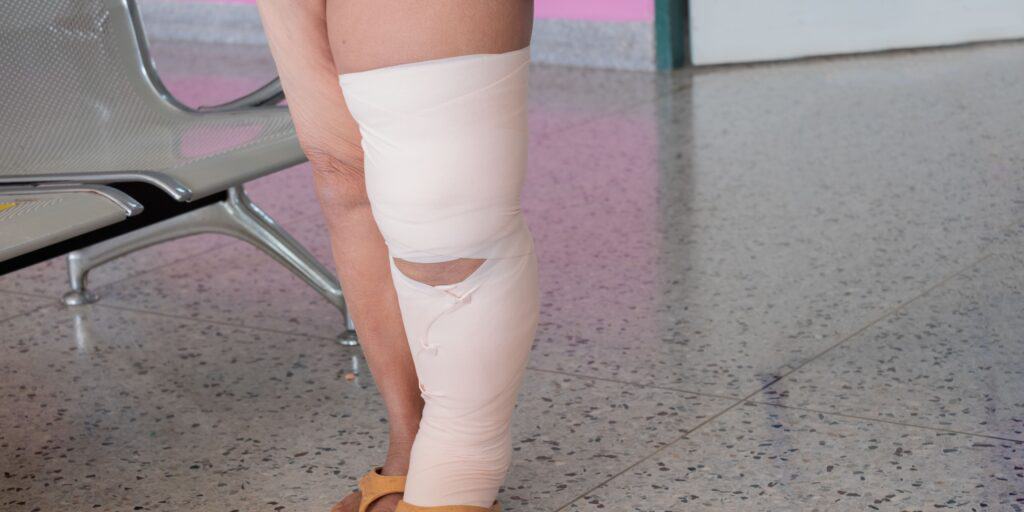Diagnosis and Treatment Options
What you may recognize as a swelling leg or a swollen leg is a common condition called lymphoedema. This condition is brought about by the accumulation of lymph (lymphatic fluid) in a certain part of your body, most commonly your arms or your legs. This fluid is what causes the swelling, and can bring about symptoms like fatigue, a limited range of motion, hardening of the skin, and an increased likelihood of infections. When you have lymphoedema, you will have to be a lot more careful about being injured, as these injuries are likely to take a longer time to treat and heal.
DIAGNOSIS
● Computerised Topography (CT) scan: A CT scan uses X-rays to take images of your body from various different angles. The computer then combines the images to form a cross-sectional image of your body. This allows the doctor to look for any secondary causes of lymphatic channel blockage such as tumours.
● Ultrasound scan: Ultrasound waves are bounced against the structures in the body to create an image of those internal structures. A venous ultrasound scan is usually performed to exclude venous reflux or deep venous thrombosis as a cause of the swollen leg.
● Lymphoscintigraphy: In this procedure, radiotracers (radioactive dye) are injected into the body to be evaluated, and then a scan is conducted to observe the movement of the dye through the lymphatic system. You will be able to see any lymphatic channel blockages based on where the dye is unable to flow.
Some tests may also be conducted to eliminate other possible causes of leg swelling like vein disease, muscle and soft tissue infections and injury. It is important for the doctor to be sure about the diagnosis because treatment has to be targeted and accurate in order to yield good results.

TREATMENT
There are a few different ways that lymphoedema can be treated, depending on the severity of the condition. For early-stage lymphoedema, compression therapy with compression garments and lymphatic drainage massage may suffice as treatment to alleviate the symptoms of lymphoedema.
● Compression garments: Compression garments are made of a material that is elastic and tight-fitting around your skin. They function by compressing the affected limb and thus reduce the accumulation of lymph and encourage the drainage of the lymph from that limb. Your doctor will have to make measurements and tailor the compression garment to your body so that the right amount of pressure is applied. Compression garments may also be used in conjunction with other treatment methods such as after lymphatic drainage massage or after lymphovenous bypass surgery.
● Lymphatic drainage massage: This has to be done regularly (at least 3 times a week). During the massage, excess lymphatic fluid is moved gently to other parts of the lymphatic system where they can be effectively drained. There is evidence that lymphatic drainage massage can also help to reduce anxiety and boost immunity, among other benefits.
Before the lymphatic drainage massage, make sure to stay hydrated, eat as little food as possible, and consult your doctor about any medications you are currently taking. Dosages of some medications may have to be changed slightly before the massage. [4]
Surgery for early-stage lymphoedema is also available. These include lymphovenous bypass and lymph node transplant/transfer
● Lymphovenous bypass: This is a surgical procedure where the healthy part of a lymph vessel is connected to a nearby vein, thus allowing lymph to flow freely out of the affected limb and bypassing any obstructed segments. Results of the surgery may take up to a year after to be noticed.
● Lymph node transplant: This is a procedure to transfer a healthy lymph node together with its draining blood vessel from one part of your body to the another part which is affected by lymphoedema. Over time, this transplanted lymph node will then connect to the lymphatic vessels of the affected limb and help to reduce the swelling in the limb. After the surgery, you may have to wear light compression garments for a while.
If lymphoedema progresses to an advanced stage, other surgical treatments are required.
● Debulking: This is the surgical procedure to directly remove the excess tissue and fluid of lymphoedema. Skin grafts may have to be used from other parts of your body to help with wound healing.
● Liposuction: A vacuum is inserted into the skin to suck out the excess tissue and fluid, much like debulking. However, this treatment procedure is less invasive than debulking, and the recovery will therefore be faster. Scarring from the procedure will also be less.
Lymphoedema can affect your quality of life and make day to day activities difficult. In this way, swelling leg treatment, Singapore, can prove help in restoring your ability to live normally. Unfortunately, lymphoedema cannot be completely cured, but the swelling and symptoms can be reduced.
Should you want to have lymphoedema/swelling leg treatment, Singapore Vascular and Interventional Centre is always available. Feel free to book an appointment with us today! Contact details have been included below:
6694 6270 (Call)
9898 3595 (WhatsApp)
en*****@***********tr.com (Email)
- Tags:
- Causes of swollen legs
- Chronic leg swelling Singapore
- Leg edema treatment Singapore
- Leg fluid retention treatment
- Leg inflammation care Singapore
- Lower limb swelling relief
- Lymphedema Singapore treatment
- LYMPHOEDEMA
- One leg swelling solution
- Persistent leg swelling Singapore
- Singapore leg specialist
- Singapore vascular clinic
- Swelling Leg Treatment Singapore
- Swollen ankle and leg care
- Swollen Leg Treatment Singapore
- Swollen leg vein issue
- Swollen legs doctor Singapore
- Treating swollen feet Singapore
- Treatment for heavy legs
- Vascular leg swelling
- Vein-related leg swelling
- Venous insufficiency treatment
